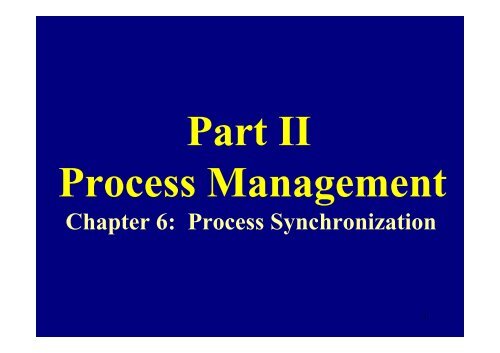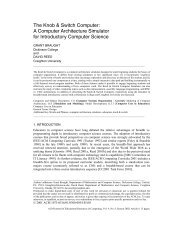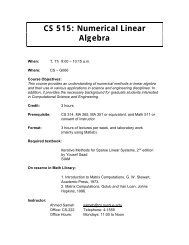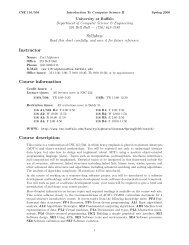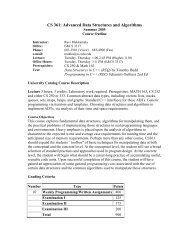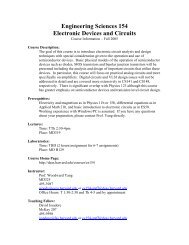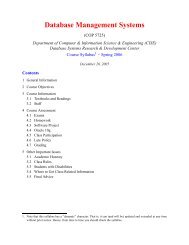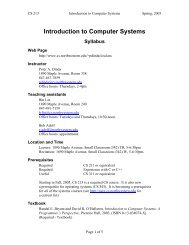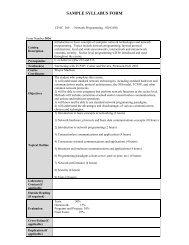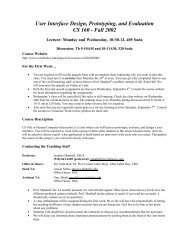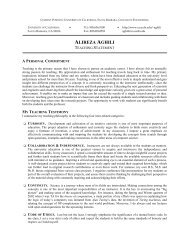Chapter 6: Process Synchronization - Csl Mtu
Chapter 6: Process Synchronization - Csl Mtu
Chapter 6: Process Synchronization - Csl Mtu
You also want an ePaper? Increase the reach of your titles
YUMPU automatically turns print PDFs into web optimized ePapers that Google loves.
Part II<br />
<strong>Process</strong> Management<br />
<strong>Chapter</strong> 6: <strong>Process</strong> <strong>Synchronization</strong><br />
1
<strong>Process</strong> <strong>Synchronization</strong><br />
• Why is synchronization needed?<br />
• Race Conditions<br />
• Critical Sections<br />
• Pure Software Solutions<br />
• Hardware Support<br />
• Semaphores<br />
• Monitors<br />
• Message Passing<br />
2
Why is <strong>Synchronization</strong> Needed? 1/4<br />
int Count = 10;<br />
<strong>Process</strong> 1 <strong>Process</strong> 2<br />
Count++; Count--;<br />
Count = ? 9, 10 or 11?<br />
3
Why is <strong>Synchronization</strong> Needed? 2/4<br />
int Count = 10;<br />
<strong>Process</strong> 1 <strong>Process</strong> 2<br />
LOAD Reg, Count LOAD Reg, Count<br />
ADD #1 SUB #1<br />
STORE Reg, Count STORE Reg, Count<br />
The problem is that the execution flow may be<br />
switched in the middle!<br />
4
Why is <strong>Synchronization</strong> Needed? 3/4<br />
<strong>Process</strong> 1 <strong>Process</strong> 2<br />
Inst Reg Memory Inst Reg Memory<br />
LOAD<br />
10<br />
10<br />
LOAD<br />
10<br />
10<br />
SUB<br />
9<br />
10<br />
ADD<br />
11<br />
10<br />
STORE<br />
11<br />
11<br />
erases the previous value 11<br />
STORE<br />
9<br />
9<br />
5
Why is <strong>Synchronization</strong> Needed? 4/4<br />
<strong>Process</strong> 1 <strong>Process</strong> 2<br />
Inst Reg Memory Inst Reg Memory<br />
LOAD<br />
10<br />
10<br />
ADD<br />
11<br />
10<br />
LOAD<br />
10<br />
10<br />
SUB<br />
9<br />
10<br />
STORE<br />
9<br />
9<br />
STORE<br />
11<br />
11<br />
erases the previous value 9<br />
6
Race Conditions<br />
A Race Condition occurs, if<br />
two or more processes/threads access and<br />
manipulate the same data concurrently, and<br />
the outcome of the execution depends on the<br />
particular order in which the access takes<br />
place.<br />
<strong>Synchronization</strong> is needed to prevent race<br />
conditions from happening.<br />
<strong>Synchronization</strong> is a difficult topic. Don’t miss<br />
a class; otherwise, you will miss a lot of things.<br />
7
Critical Section and Mutual Exclusion<br />
A critical section is a section of code in which a<br />
process accesses shared resources.<br />
Thus, the execution of critical sections must be<br />
mutually exclusive (e.g., at most one process can<br />
be in its critical section at any time).<br />
The critical-section problem is to design a<br />
protocol that processes can use to cooperate.<br />
int count; // shared<br />
critical sections<br />
count++; count--; cout
The Critical Section Protocol<br />
do {<br />
entry section<br />
critical section<br />
exit section<br />
A critical section protocol<br />
consists of two parts: an<br />
entry section and an exit<br />
section.<br />
Between them is the<br />
critical section that must<br />
run in a mutually<br />
exclusive way.<br />
} while (1);<br />
9
Solutions to the Critical Section Problem<br />
Any solution to the critical section problem<br />
must satisfy the following three conditions:<br />
Mutual Exclusion<br />
Progress<br />
Bounded Waiting<br />
Moreover, the solution cannot depend on<br />
CPU’s relative speed and scheduling policy.<br />
10
Mutual Exclusion<br />
If a process P is executing in its critical section,<br />
then no other processes can be executing in their<br />
critical sections.<br />
The entry protocol should be capable of<br />
blocking processes that wish to enter but cannot.<br />
Moreover, when the process that is executing in<br />
its critical section exits, the entry protocol must<br />
be able to know this fact and allows a waiting<br />
process to enter.<br />
11
Progress<br />
If no process is executing in its critical section<br />
and some processes wish to enter their critical<br />
sections, then<br />
Only those processes that are waiting to enter<br />
can participate in the competition (to enter<br />
their critical sections).<br />
No other process can influence this decision.<br />
This decision cannot be postponed indefinitely.<br />
12
Bounded Waiting<br />
After a process made a request to enter its<br />
critical section and before it is granted the<br />
permission to enter, there exists a bound on the<br />
number of times that other processes are<br />
allowed to enter.<br />
Hence, even though a process may be blocked<br />
by other waiting processes, it will not be waiting<br />
forever.<br />
13
Software Solutions for<br />
Two <strong>Process</strong>es<br />
Suppose we have two processes, P 0 and P 1 .<br />
Let one process be P i and the other be P j , where<br />
j = 1- i. Thus, if i = 0 (resp., i = 1), then j = 1<br />
(resp., j = 0).<br />
We want to design the enter-exit protocol for a<br />
critical section so that mutual exclusion is<br />
guaranteed.<br />
14
Algorithm I: 1/2<br />
process P i<br />
do {<br />
while (turn != i);<br />
turn = j;<br />
} while (1);<br />
if it is not my turn, I wait<br />
critical section<br />
exit<br />
enter<br />
I am done, it is your turn now<br />
Global variable<br />
turn controls who<br />
can enter the<br />
critical section.<br />
Since turn is either<br />
0 or 1, only one can<br />
enter.<br />
However, processes<br />
are forced to run in<br />
an alternating way.<br />
15
Algorithm I: 2/2<br />
process P i<br />
do {<br />
while (turn != i);<br />
critical section<br />
turn = j;<br />
} while (1);<br />
if it is not my turn, I wait<br />
exit<br />
enter<br />
I am done, it is your turn now<br />
This solution does<br />
not fulfill the<br />
progress condition.<br />
If P j exits by setting<br />
turn to i and<br />
terminates, P i can<br />
enter but cannot<br />
enter again.<br />
Thus, an irrelevant<br />
process can block<br />
other processes<br />
from entering a<br />
critical section. 16
Algorithm II: 1/2<br />
bool flag[2];<br />
I am interested<br />
do {<br />
wait for you<br />
}<br />
flag[i] = TRUE;<br />
while (flag[j]);<br />
critical section<br />
flag[i] = FALSE;<br />
I am not interested<br />
enter<br />
exit<br />
Variable flag[i]<br />
is the “state” of<br />
process P i :<br />
interested or notinterested.<br />
P i expresses its<br />
intention to enter,<br />
waits for P j to exit,<br />
enters its section,<br />
and finally changes<br />
to “I am out” upon<br />
exit.<br />
17
Algorithm II: 2/2<br />
bool flag[2];<br />
I am interested<br />
do {<br />
wait for you<br />
}<br />
flag[i] = TRUE;<br />
while (flag[j]);<br />
critical section<br />
flag[i] = FALSE;<br />
I am not interested<br />
The correctness of this<br />
algorithm is timing<br />
dependent!<br />
If both processes set<br />
enter flag[i] and<br />
flag[j] to TRUE at<br />
the same time, then<br />
both will be looping at<br />
exit the while forever<br />
and no one can enter.<br />
Bounded waiting does<br />
not hold.<br />
18
Algorithm III: a Combination 1/4<br />
// process P i<br />
bool flag[2];<br />
int turn;<br />
I am interested<br />
do {<br />
yield to you first<br />
I am done<br />
flag[i] = TRUE;<br />
turn = j;<br />
while (flag[j] && turn == j);<br />
critical section<br />
flag[i] = FALSE;<br />
exit<br />
enter<br />
wait while you are<br />
interested and it is<br />
your turn.<br />
}<br />
19
Algorithm III: Mutual Exclusion 2/4<br />
flag[i] = TRUE;<br />
turn = j;<br />
while (flag[j] && turn == j);<br />
process P i<br />
If both processes are in their critical sections, then<br />
flag[j] && turn == j (P i ) and flag[i] && turn<br />
== i (P j ) are both FALSE.<br />
flag[i] and flag[j] are both TRUE<br />
Thus, turn == i and turn == j are FALSE.<br />
Since turn can hold one value, only one of turn == i<br />
or turn == j is FALSE, but not both.<br />
We have a contradiction and P i and P j cannot be in their<br />
critical sections at the same time.<br />
20
Algorithm III: Progress 3/4<br />
flag[i] = TRUE;<br />
turn = j;<br />
while (flag[j] && turn == j);<br />
process P i<br />
If P i is waiting to enter, it must be executing its<br />
while loop.<br />
Suppose P j is not in its critical section:<br />
If P j is not interested in entering, flag[j] was<br />
set to FALSE when P j exits. Thus, P i may enter.<br />
If P j wishes to enter and sets flag[j] to TRUE,<br />
it will set turn to i and P i may enter.<br />
In both cases, processes that are not waiting do not<br />
block the waiting processes from entering.<br />
21
Algorithm III: Bounded Waiting 4/4<br />
flag[i] = TRUE;<br />
turn = j;<br />
while (flag[j] && turn == j);<br />
process P i<br />
When P i wishes to enter:<br />
If P j is outside of its critical section, then flag[j] is<br />
FALSE and P i may enter.<br />
If P j is in its critical section, eventually it will set<br />
flag[j] to FALSE and P i may enter.<br />
If P j is in the entry section, P i may enter if it reaches<br />
while first. Otherwise, P j enters and P i may enter<br />
after P j sets flag[j] to FALSE and exits.<br />
Thus, P i waits at most one round!<br />
22
Hardware Support<br />
There are two types of hardware<br />
synchronization supports:<br />
Disabling/Enabling interrupts: This is slow<br />
and difficult to implement on multiprocessor<br />
systems.<br />
Special privileged machine instructions:<br />
‣Test and set (TS)<br />
‣Swap<br />
‣Compare and Swap (CS)<br />
23
Interrupt Disabling<br />
do {<br />
entry<br />
disable interrupts<br />
critical section<br />
enable interrupts<br />
exit<br />
} while (1);<br />
Because interrupts are<br />
disabled, no context<br />
switch will occur in a<br />
critical section.<br />
Infeasible in a<br />
multiprocessor system<br />
because all CPUs must<br />
be informed.<br />
Some features that<br />
depend on interrupts<br />
(e.g., clock) may not<br />
work properly.<br />
24
Special Machine Instructions<br />
Atomic: These instructions execute as one<br />
uninterruptible unit. More precisely, when such<br />
an instruction runs, all other instructions being<br />
executed in various stages by the CPUs will be<br />
stopped (and perhaps re-issued later) until this<br />
instruction finishes.<br />
Thus, if two such instructions are issued at the<br />
same time, even though on different CPUs, they<br />
will be executed sequentially.<br />
Privileged: These instructions are, in general,<br />
privileged, meaning they can only execute in<br />
supervisor or kernel mode.<br />
25
The Test-and-Set Instruction<br />
bool TS(bool *key)<br />
{<br />
bool save = *key;<br />
*key = TRUE;<br />
return save;<br />
}<br />
Mutual exclusion is<br />
obvious as only one TS<br />
instruction can run at a<br />
time.<br />
However, progress and<br />
bounded waiting may<br />
not be satisfied.<br />
bool lock = FALSE;<br />
do {<br />
entry<br />
while (TS(&lock));<br />
critical section<br />
lock = FALSE; exit<br />
} while (1);<br />
26
Problems with Software and<br />
Hardware Solutions<br />
All of these solutions use busy waiting.<br />
Busy waiting means a process waits by executing a tight<br />
loop to check the status/value of a variable.<br />
Busy waiting may be needed on a multiprocessor system;<br />
however, it wastes CPU cycles that some other processes<br />
may use productively.<br />
Even though some personal/lower-end systems may allow<br />
users to use some atomic instructions, unless the system<br />
is lightly loaded, CPU and system performance can be<br />
low, although a programmer may “think” his/her<br />
program looks more efficient.<br />
So, we need a better solution.<br />
27


